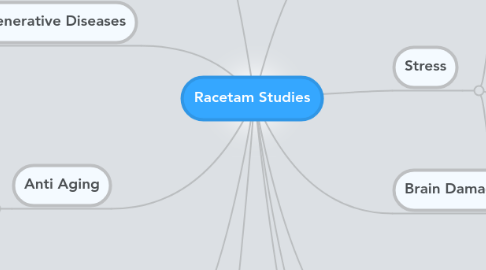
1. Anti Aging
1.1. Piracetam improves mitochondrial dysfunction following oxidative stress.
1.2. Effects of piracetam on membrane fluidity in the aged mouse, rat, and human brain.
1.3. The effects of oxiracetam in patients with organic brain syndrome
2. Cognition
2.1. Design and study of piracetam-like nootropics, controversial members of the problematic class of cognition-enhancing drugs.
2.2. Prevention of postoperative cognitive dysfunction
2.3. Some neurochemical properties of pramiracetam (CI-879), a new cognition-enhancing agent
2.4. Piracetam and other structurally related nootropics.
3. Memory
3.1. Adrenals
3.1.1. Do piracetam-like compounds act centrally via peripheral mechanisms?
3.2. Learning
3.2.1. Enhancement of hippocampally-mediated learning and protein kinase C activity by oxiracetam in learning-impaired DBA/2 mice.
3.3. Long Term Potentiation
3.3.1. Effect of the nootropic drug oxiracetam on field potentials of hippocampal slices
3.4. Nueroplasticity
3.4.1. Brain-derived neurotrophic factor mechanisms and function in adult synaptic plasticity: new insights and implications for therapy.
3.5. Spacial Memory
3.5.1. The effect of pramiracetam (CI-879) on the acquisition of a radial arm maze task.
3.6. Effects of combined treatment with heavy metals and Piracetam on learning and memory
3.7. Piracetam--an old drug with novel properties?
3.8. Piracetam improves children's memory after general anaesthesia.
3.9. Memory training and drug therapy act differently on memory and metamemory functioning: evidence from a pilot study.
3.10. Relationships between arousal and cognition-enhancing effects of oxiracetam.
4. Nuerodegenerative Diseases
4.1. Alzheimer's Disease
4.1.1. AMPA receptor potentiators for the treatment of CNS disorders.
4.2. Dementia
4.2.1. Oxiracetam in the treatment of multi-infarct dementia and primary degenerative dementia.
4.3. Aniracetam. An overview of its pharmacodynamic and pharmacokinetic properties, and a review of its therapeutic potential in senile cognitive disorders.
5. Fasoracetam
5.1. Evidence?
5.2. Mechanism of Action
5.2.1. Cholinergic
5.2.2. Gaba
5.2.3. Glutamate
5.3. ADHD
5.4. Biohacker Review
5.5. Motivation
5.6. Dosage
5.7. Related Rant
5.8. Side Effects
5.8.1. Effect on Orgasm
5.8.2. Anxiety
5.8.3. Drowsiness
6. Stress
6.1. Oxidative stress in a model of toxic demyelination in rat brain: the effect of piracetam and vinpocetine.
6.2. Analgesic activity of piracetam: effect on cytokine production and oxidative stress.
6.3. Piracetam improves mitochondrial dysfunction following oxidative stress.
7. Brain Damage
8. Addiction
8.1. Alcoholism
8.1.1. Explorative and drinking behavior after prolonged access to alcohol and following chronic piracetam
8.1.2. Therapy with parenteral piracetam in alcohol withdrawal
8.1.3. High versus low-dose piracetam in alcohol organic mental disorder
